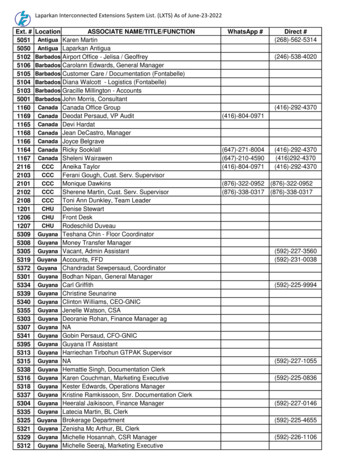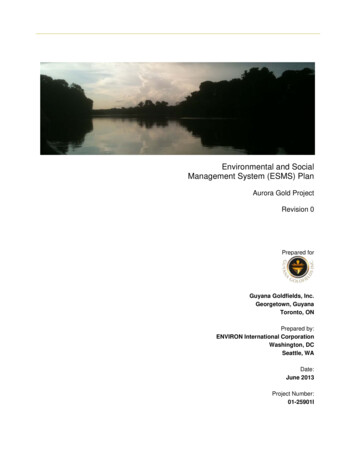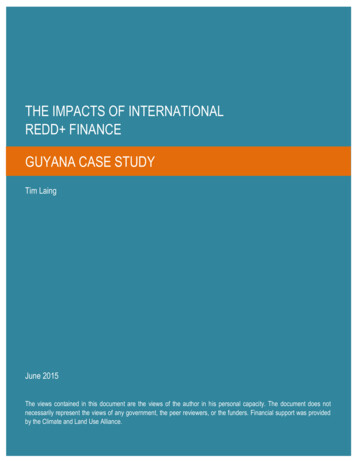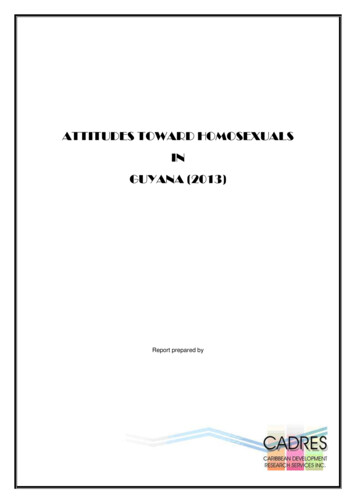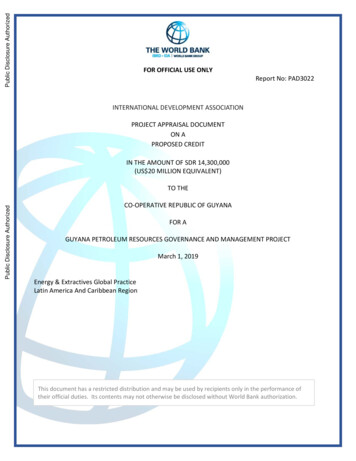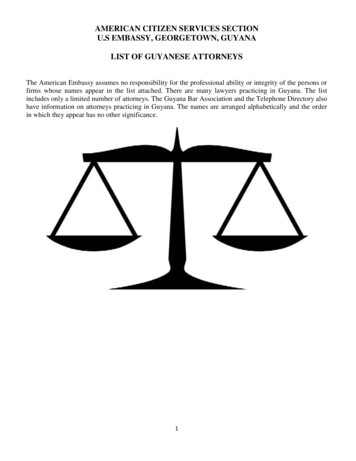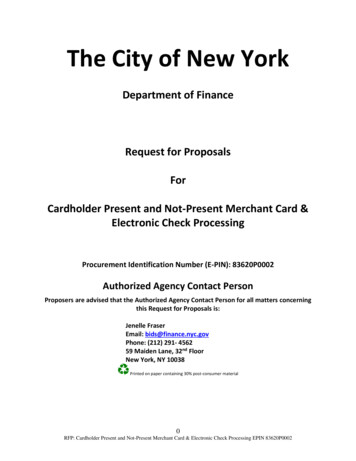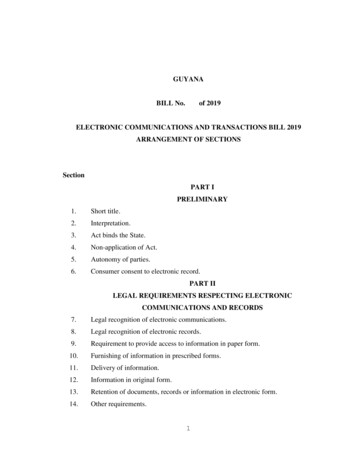
Transcription
GUYANABILL No.of 2019ELECTRONIC COMMUNICATIONS AND TRANSACTIONS BILL 2019ARRANGEMENT OF SECTIONSSectionPART IPRELIMINARY1.Short title.2.Interpretation.3.Act binds the State.4.Non-application of Act.5.Autonomy of parties.6.Consumer consent to electronic record.PART IILEGAL REQUIREMENTS RESPECTING ELECTRONICCOMMUNICATIONS AND RECORDS7.Legal recognition of electronic communications.8.Legal recognition of electronic records.9.Requirement to provide access to information in paper form.10.Furnishing of information in prescribed forms.11.Delivery of information.12.Information in original form.13.Retention of documents, records or information in electronic form.14.Other requirements.1
15.Comparison of documents with original.16.Admissibility and evidential weight of electronic communications.PART IIIELECTRONIC CONTRACTS17.Formation and validity of contracts.18.Effectiveness between parties.19.Invitation to make offer.20.Use of automated message systems for contract formation.21.Error in electronic .Time of dispatch.25.Time of receipt.26.Place of dispatch and receipt.PART IVELECTRONIC SIGNATURES27.Requirement for signature.28.Equal treatment of signatures.29.Conduct of relying party.30.Conduct of the signatory.31.Conduct of electronic security procedures providers.32.Recognition of foreign certificates and electronic signatures.PART VSECURE ELECTRONIC COMMUNICATIONS,RECORDS AND SIGNATURES33.Secure electronic communication or record.34.Secure electronic signature.35.Presumptions relating to secure electronic communications, records andsignatures.2
PART VIELECTRONIC SECURITY PROCEDURES PROVIDERS36.Designated authority.37.Electronic security procedures and providers.38.Regulation of security procedures and security procedure providers.PART VIIELECTRONIC RECORDS, INFORMATION, SIGNATURES,ELECTRONIC SYSTEMS IN PUBLIC AUTHORITIES39.Use of electronic records, information and signatures by public authorities.40.Establishment of electronic systems.PART VIIIINTERMEDIARIES AND ELECTRONIC-COMMERCESERVICE PROVIDERS41.Liability of intermediaries.42.Procedure for dealing with unlawful or defamatory information.43.Codes of conduct and standards for intermediaries and e-commerce serviceproviders.PART IXCONSUMER PROTECTION44.Consumer protection.45.Right of rescission.46.Unwanted communications.PART XMISCELLANEOUS47.Audit of documents, etc.48.Regulations.49.Act to have overriding effect.50.Removal of difficulties.SCHEDULE3
A BILLIntituledAN ACT to provide for the facilitation and regulation of secure electroniccommunications and transactions and for their legal recognition, to promote thedevelopment of the legal and business infrastructure necessary to implement secureelectronic commerce and to enhance efficient delivery of governance by publicauthorities by means of reliable electronic records and electronic filing ofdocuments and for related matters.A.D. 2019Enacted by the Parliament of Guyana:-PART IPRELIMINARYShort title.1. This Act may be cited as the Electronic Communications andTransactions Act 2019.Interpretation.2. ( 1) In this Act –“addressee” in relation to an electronic communication,means a person who is intended by the originator toreceive the electronic communication, but does notinclude a person acting as an intermediary with respectto that electronic communication;"automated message system" means a computer program oran electronic or other automated means used to initiatean action or respond to electronic communications orperformances in whole or in part, without review orintervention by a natural person each time an action is4
initiated or a response is generated by the program orelectronic or other means;“certificate” means an electronic record that confirms thelink between a signatory and the signature creationdata, identifies the signatory and the entity that issuesit and includes other information such as itsoperational period;"communication" includesany statement,declaration,demand, notice, request, offer or the acceptance of anoffer, that the parties are required to make or choose tomake in connection with the formation or performanceof a contract;“consumer” means any person who enters or intends to enterinto an electronic transaction with an electroniccommerce service provider as the end user of thegoods or services offered by the provider;“Court” means the High Court of Guyana;“data” means any document, correspondence, memorandum,book, plan, map, drawing, pictorial or graphic otape, machine-readable record and any otherdocumentary material, regardless of physical form orcharacteristics, and any copy of those things;“digital signature” means is an electronic signature that canbe used to authenticate the identity of the sender of amessage or the signer of a document;“electronic” includes electrical, digital, magnetic, wireless,optical, electro-magnetic, biometric, photonic andsimilar capabilities;5
“electronic-commerce service provider” means a person whouses electronic means in providing goods or servicesor both;“electronic communication” means information which d, stored, generated, received or transmitted byelectronic means;“electronic form” with reference to information, means anyinformation generated, sent, received or stored inmedia, magnetic form, optical form, computermemory, microfilm, computer generated microfiche orsimilar municated, received or stored by electronic meansin an information system or for transmission from oneinformation system to cedureestablished under section 37 or agreement orknowingly adopted by each party, that is employed forthe purpose of verifying that an electronic signature,communication or performance is that of a particularperson or for detecting changes or errors in content ofan electronic communication such as a certificate;"electronic security procedure provider" means a personinvolved in the provision of an electronic securityprocedure and related services;“electronic signature” means the various ways that anelectronic document or record can be signed, such as adigitized image of a signature, a name typed at the end6
of an e-mail message by the sender, a biometricidentifier, a secret code or PIN, or a digital signature;“electronic transactions” includes the single communicationor outcome of multiple communications involved inthe sale or purchase of goods and services conductedover computer-mediated networks or informationsystems, where the goods and services may be orderedthrough such networks or systems but the payment andultimate delivery of the goods and services may occurwithout the use of such networks or systems;“information” includes data, text, documents, images,sounds, codes, computer programmes, software anddatabases;"information system" means a system for generating,sending, receiving, storing or otherwise processingelectronic records;“intermediary” with respect to an electronic communication,means a person including a host who on behalf ofanother person, sends, receives, transmits or storeseither temporarily or permanently that electroniccommunication or provides related services withrespect to that electronic communication and includestelecommunication service providers, network serviceproviders, internet service providers, search engines,online payment sites, online auction sites, onlinemarket places and cyber cafes;“Minister” means the Minster with responsibility forelectronic commerce;"originator", in relation to an electronic communication,7
means a party by whom, or on whose behalf, theelectronic communication has been sent or generatedprior to storage, if any, but does not include a partyacting as an intermediary with respect to thatelectronic communication;“public authority” means any Ministry, department, agency,board, commission, local democratic organ or otherbody of the Government and includes an entity orbody established by law or by arrangement of theGovernment or a Minister for a non-commercialpublic service purpose;“record” means information that is inscribed, stored orotherwise fixed on a tangible medium or that is storedin an electronic, paper-based or other medium and isretrievable in visible form;"secure electronic communication or record" means anelectronic record that is treated as a secure electronicrecord by virtue of section 33(1);"secure electronic signature" means an electronic signaturethat is treated as a secure electronic signature by virtueof section 34;“signatory” means a person who may or may not hold asignature-creation device and acts either on his or itsown behalf or on behalf of another person to create anelectronic signature;“signature creation data” means unique data, including codesor private cryptographic keys or a uniquely configuredphysical device which is used by the signatory increating an electronic signature;8
“signed” or “signature” and its grammatical variations meansa method (electronic or otherwise) used to identify aperson and to indicate the intention of that person inrespect of the information contained in a record.(2) In this Act, “place of business”, in relation to a party, means –(a) any place where the party maintains a non-transitoryestablishment to pursue an economic activity otherthan the temporary provision of goods or servicesout of a specific location; or(b) if the party is a natural person and he does not havea place of business, the person’s habitual residence.(3) For the purposes of subsection (2) —(a) if a party has indicated his place of business, thelocation indicated by him is presumed to be his placeof business unless another party proves that the partymaking the indication does not have a place ofbusiness at that location;(b) if a party has not indicated a place of business andhas more than one place of business, then the placeof business is that which has the closest relationshipto the relevant contract, having regard to thecircumstances known to or contemplated by theparties at any time before or at the conclusion of thecontract;(c) a location is not a place of business merely becausethat location is —(i) where equipment and technology supporting9
an information system used by a party inconnection with the formation of a contractare located; or(ii) where the information system may beaccessed by other parties; and(d) the sole fact that a party makes use of a domain nameor an electronic mail address connected to a specificcountry does not create a presumption that its placeof business is located in that country.(4) Where an electronic communication does not relate to anycontract, references to a contract in subsection (3) shall refer to therelevant transaction.Act binds the State.3. (1) This Act binds the State.(2) Except as otherwise provided, nothing in this Act obliges anypublic authority to generate, send, receive, store or otherwiseprocess any record by electronic means, but the Minister may, bynotice published in the Gazette, declare that a public authority mayreceive and process electronic communications relating to thematters specified in the notice.Non-application of Act.Schedule4. (1) This Act does not apply to the documents and transactionsspecified in the Schedule.(2) The Minister may, by order, amend the Schedule.Autonomy of parties.5. (1) Nothing in this Act shall –10
(a) require any person to use or accept electroniccommunications, electronic signatures or electroniccontracts; or(b) prohibit any person engaging in a transaction throughthe use of electronic means from(i) varying by agreement any provision specifiedin Parts II, III, and IV;(ii) establishing reasonable requirements aboutthemannerinwhichelectroniccommunications, electronic signatures orelectronic forms of documents may beaccepted.(2) A transaction which has been conducted using electronicmeans shall not be denied legal effect, validity or enforceabilitysolely for the reason of the type or method of electroniccommunication, electronic signature or electronic authenticationselected by the parties.Consumer consent toelectronic record.6. Where a statutory or legal requirement exists for a record to beprovided in writing (paper form) to a consumer, the requirement forwriting shall be satisfied by the record provided in electronic form if–(a) the consumer has expressly consented to the use and hasnot withdrawn his consent; and(b) prior to consenting, the consumer is provided with i)about the right to have the record provided in11
paper form;(ii)about the right to withdraw consent to have therecord provided in electronic form and of anyconditions, consequences or fees in the event ofthe withdrawal;(iii) whether the consent applies only to theparticular transaction which gave rise to theobligation to provide the record, or to identifiedcategories of records that may be providedduring the course of the parties’ relationship;(iv) of the hardware and software requirements foraccess to, and retention of, the relevantelectronic record;(v)of the procedures for withdrawal of consent andto update information needed to contact theconsumer electronically; and(vi) of the procedures, after consent has been given,for obtaining a paper copy of the electronicrecord and any fee to be charged;(c) the record is accessible to the consumer in a mannerusable for subsequent reference.PART IILEGAL REQUIREMENTS RESPECTINGELECTRONIC COMMUNICATIONS AND RECORDSLegal recognitionof electroniccommunications.7. An electronic communication shall not be denied legal effect,validity, admissibility or enforceability solely on the ground that it is–12
(a) rendered or made available in electronic form; or(b) not contained in the electronic communicationpurporting to give rise to legal effect but is referredto in that electronic communication.Legal recognition ofelectronic records.8. (1) Where any information or other matter is required by law tobe given or rendered in writing or recorded in writing or in printedform or is described by law as being written, then, notwithstandinganything contained in that law, the requirement or description issatisfied if the information or matter is(a) rendered or recorded or made available in electronicform; and(b) accessible to, and is capable of retention by, theintended recipient so as to be usable or retrievablefor a subsequent reference.(2) Subsection (1) shall apply whether the requirement for theinformation to be in writing or recorded in writing is in the form ofan obligation or the law provides consequences if it is not in writing.(3) Where subsection (1) applies, a legal requirement to providemultiple copies of any information or other matter to the sameperson at the same time is met by providing a single electronic formof the information or other matter.(4) In subsection (1), giving information includes, but is notlimited to, the following(a) making an application;(b) filing, making or lodging a claim;13
(c) giving, sending or serving a notice;(d) filing or lodging a return;(e) making a request or requisition;(f) making a declaration;(g) filing, lodging or issuing a certificate;(h) making, varying or cancelling an option;(i)filing or lodging an objection or reply; or(j)giving a statement of reasons.(5) Where any information is retained in electronic form inaccordance with subsection (1) and is retrievable at any time duringthe specified period of retention, the paper of that information neednot be retained.Requirement to provideaccess to information inpaper form.9. A legal requirement to provide access to information that is inpaper or other non-electronic form is satisfied by providing access tothe information in electronic form where(a)the form and means of access to the informationreliably assures the maintenance of the integrity of theinformation, given the purpose for which, and thecircumstances in which, access to the information isrequired to be provided; and(b)the person to whom access is required to be providedconsents to accessing the information in that electronicform.Furnishing ofinformation inprescribed forms.10. Notwithstanding anything contained in any law, a legalrequirement that a person provides information in a prescribed paperor other non-electronic form to another person is satisfied by14
providing the information in an electronic form that (a)contains the same or substantially the same informationas the prescribed paper or other non-electronic form;(b)is accessible to the other person so as to be usable orretrievable for subsequent reference; and(c)Delivery ofinformation.is capable of being retained by the other person.11. (1) Where information is required by law to be delivered,dispatched, given or sent to, or to be served on, a person, thatrequirement is met by doing so in the form of an electronic recordprovided that the originator of the electronic record states that thereceipt of the electronic record is to be acknowledged and theaddressee has acknowledged its receipt.(2) Subsection (1) applies whether the requirement for delivery,dispatch, giving, sending or serving is in the form of an obligation orthe law provides consequences for the information not beingdelivered, dispatched, given, sent or served.Information in originalform.12. (1) Where information is required by law to be presented orretained in its original form, that requirement is met by an electroniccommunication or electronic record, respectively, if(a) there exists a reliable assurance as to the integrity ofthe information from the time it was first generatedin its final form as an electronic communication orelectronic record; and(b) where it is required that information be presented,that information is capable of being accuratelyrepresented to the person to whom it is to be15
presented.(2) Subsection (1) shall apply whether the requirement for theinformation to be presented or retained in its original form is in theform of an obligation or the law provides consequences if it is notpresented or retained in its original form.(3) For the purposes of subsection (1)(a)(a) the criterion for assessing integrity is whether theinformation has remained complete and unaltered,apart from the additions of any endorsement and anychange which arises in the normal course ofcommunication, storage and display; and(b) the standard of reliability required is to be assessedin the light of the purpose for which the informationwas generated and all the relevant circumstances.Retention ofdocuments, records orinformation inelectronic form.13. (1) Where any document, record or information is required bylaw to be retained in paper or other non-electronic form, thatrequirement is met by retaining it in electronic form if the followingconditions are satisfied(a)the document, record or information contained inelectronic form is accessible so as to be usable forsubsequent reference;(b)the electronic communication is retained in theformat in which it was generated, sent or received, orin a format which can be demonstrated to representaccurately the document, record or informationgenerated, sent or received; and16
(c)any information that enables the identification of theoriginanddestinationofanelectroniccommunication and the date and time when it wassent or received is retained.(2)An obligation to retain any document, record orinformation in accordance with subsection (1) shall not extend toany information the sole purpose of which is to enable the messageto be sent or received.(3) A person may satisfy the requirement referred to insubsection (1) by using the services of any other person if theconditions set out in subsection (1) are met.(4) Nothing in this section shall preclude any public authorityfrom specifying additional requirements for the retention ofelectronic communications that are subject to the jurisdiction of suchpublic authority.Other requirements.14. (1) An expression in a law, whether used as a noun or verb,including the terms “document", "record", "file", "submit", "lodge","deliver", "issue", "publish", "write in", "print" or words orexpressions of similar effect, must be interpreted so as to include orpermit such form, format or action in relation to an electronic recordunless otherwise provided for in this Act.(2) Where a seal is required by law to be affixed to adocument and such law does not prescribe the method or form bywhich such document may be sealed by electronic means, that17
requirement is met if the document indicates that it is required to beunder seal and it includes the advanced electronic signature of theperson by whom it is required to be sealed.(3) Where information or a signature, document or record isrequired by any law, or by contract or deed to be notarised,acknowledged, verified or made under oath, the requirement shall besatisfied if, in relation to electronic information, an electronicsignature, electronic document or electronic record, the electronicsignature of the person authorised to perform those acts, togetherwith all other information required to be included by otherapplicable law, is attached to or logically associated with theelectronic information, electronic signature, electronic document orelectronic record to be notorised, acknowledged, verified or madeunder oath.Comparison ofdocuments withoriginal.15. A legal requirement to compare a document with an originalmay be satisfied by comparing that document with an electronicform of the original document if the electronic form reliably assuresthe maintenance of the integrity of the document.Admissibility andevidential weight ofelectroniccommunications.16.(1) In any legal proceedings, nothing in the rules of evidenceshall apply so as to deny the admissibility of an electroniccommunication, or information or record in evidence solely on theground that it is in electronic form.(2) Information or record in the form of an electroniccommunication shall be given due evidential weight and in assessingthe evidential weight of an electronic communication, regard shall18
be given to(a) the reliability of the manner in which the itted;(b) the reliability of the manner in which the integrity ofthe information was maintained;(c) the manner in which the originator was identified;and(d) any other relevant factor.(3) This section shall not affect the application of sections 91Cap.5:03and 92 of the Evidence Act (which relate to the admissibility ofcomputer-generated evidence).PART IIIELECTRONIC CONTRACTSFormation and validityof contracts.17. (1) In the context of the formation of contracts, an offer and theacceptance of an offer or any other matter that is material in theoperation or formation of a contract may be expressed by means ofelectronic communications.(2)Where an electronic communication is used in theformation of a contract, that contract shall not be denied legal effect,validity or enforceability solely on the ground that an electroniccommunication was used for that purpose.Effectiveness betweenparties.18. As between the originator and the addressee of an electroniccommunication, a declaration of intent or other statement shall not19
be denied legal effect, validity or enforceability solely on the groundthat it is in the form of an electronic communication.Invitation to make offer.19. A proposal to conclude a contract made through one or moreelectronic communications which is not addressed to one or morespecific parties, but is generally accessible to parties making use ofinformation systems, including a proposal that makes use ofinteractive applications for the placement of orders through suchinformation systems, is to be considered as an invitation to makeoffers, unless it clearly indicates the intention of the party makingthe proposal to be bound in case of acceptance.Use of automatedmessage systems forcontract formation.20. A contract formed by the interaction of an automated messagesystem and a person, or by the interaction of automated messagesystems, shall not be denied legal validity or enforceability solely onthe ground that no person reviewed or intervened in each of theindividual actions carried out by the automated message systems orthe resulting contract.Error in electroniccontract or transaction.21. (1) An electronic contract concluded or an electronic transactionundertaken through the interaction of a person and an electronicagent of another person is void where –(a) the first referred person made a material error in theinformation;(b) the electronic agent of the second referred person did notprovide an opportunity to prevent or correct the error;(c) on becoming aware of the error, the first referred personnotifies the second referred person of the error;(d) the second referred person has taken no reasonable steps20
to correct the error; and(e) the first referred person has not received or used anymaterial benefit or value from the second referredperson.(2) Subsection (1) shall not apply to electronic auctions.(3) Where there is an agreement between the parties to use asecurity procedure to detect changes or errors in the electronicdocument and –(a) only one of the parties has conformed to the procedure;and(b) the non-conforming party would have detected thechange or error had that party also conformed,the conforming party may avoid the effect of the changed orerroneous electronic document.(4) The provisions of this section shall not be varied byagreement nor affect the application of any rule of law that maygovern the consequences of any error other than as provided for insubsections (1) and (3).Attribution.22. (1) An electronic communication is that of the originator if itwas sent by the originator himself.(2) As between the originator and the addressee, an electroniccommunication is deemed to be that of the originator if it was sent –(a) by a person who had the authority to act on behalf ofthe originator; or21
(b) by an information system programmed by or on behalfof the originator to operate automatically.(3) As between the originator and the addressee an addressee isentitled to regard an electronic communication as that of theoriginator and to act on that assumption if –(a)the addressee properly applied a procedure previouslyagreed to by the originator for that purpose; or(b) the electronic communication resulted from the actionsof a person whose relationship with the originator or anagent of the originator enabled that person to gainaccess to a method used by the originator to identifyelectronic communications as his own.(4) Subsection (3) does not apply –(a) where the addressee has received notice that theelectronic communication is not that of the originatorand the addressee has had reasonable time to act;(b) in a case within subsection (3)(b), at a time when theaddressee knew or should have known that the messagewas not that of the originator.(5) The addressee is entitled to act on the assumption that theelectronic communication as received is what the originator intendedto send unless the addressee knew or should have known that therewas an error in transmission.(6)The addressee is entitled to regard each electroniccommunication as a separate message unless it duplicates another22
message and the addressee knew or should have known.Acknowledgment.23. (1) Where the originator and addressee have not agreed on theform of acknowledgement, acknowledgement can be given by anycommunication or conduct of the addressee sufficient to indicate tothe originator that the electronic communication has been received.(2)Where the electronic communication is conditional onreceipt of acknowledgement, the electronic communication is treatedas never sent until acknowledgement is received.(3) Where the electronic communication is not conditional onreceipt of acknowledgement and the acknowledgement has not beenreceived by the time specified or a reasonable time, the originatormay give notice to the addressee specifying a reasonable time bywhich the acknowledgement must be received or may, upon noticeto the addressee, treat the electronic communication as never sent.(4) Where there is acknowledgement of receipt, it is presumedthat the electronic communication was received, but it is notpresumed that the electronic communication corresponds to theelectronic communication received.Time of dispatch of24. Unless the originator and addressee otherwise agree, anelectronicelectronic communication is dispatched –communications.(a)when it enters an information system outside thecontrol of the originator or of the party who sent it onbehalf of the originator; or(b) in the case where the originator and the addressee are23
in the same information system, when the electroniccommunication becomes capable of being retrievedand processed by the addressee.Time of receipt.25. (1) Unless the originator and addressee otherwise agree, thetime of receipt of an electronic communication is the time when theelectronic communication becomes capable of being retrieved by theaddressee at an electronic address designated by the addressee.(2) Unless the originator and addressee otherwise agree, thetime of receipt of an electronic communication at an electronicaddress that has not been designated by the addressee is the timewhen the electronic communication becomes capable of beingretrieved by the addressee at that address and the addressee becomesaware that the electronic communication has been sent to thataddress.(3)For the purposes of subsection (2), an electroniccommunication is presumed to be capable of being retrieved by theaddressee when it reaches the electronic address of the addressee.Place of dispatchand receipt.26. (1) An electronic communication is deemed to be dispatched atthe place where the originator has its place of business a
39. Use of electronic records, information and signatures by public authorities. 40. Establishment of electronic systems. PART VIII INTERMEDIARIES AND ELECTRONIC-COMMERCE SERVICE PROVIDERS 41. Liability of intermediaries. 42. Procedure for dealing with unlawful or defamatory information. 43.
